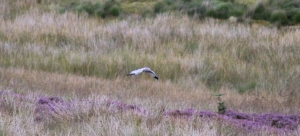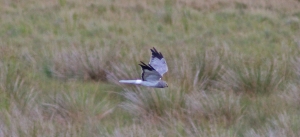Hen Harriers Circus cyaneus have had a lot of publicity in 2014. In 2013 there were no reported successfully breeding pairs in England at all. Nada, nowt, diddely squat. I won’t go into the reasons for the failures but they mostly involve shotguns and vested interests. But 2014 was a different matter there were 3 reported pairs who successfully bred which was a vast improvement. It was a great surprise therefore when not long after I finished my Ring Ouzel contract I was asked if I wanted to assist in protecting a breeding pair of Hen Harriers in the Peak District. Half of me thought it was a wind-up as it was August and the breeding season was over; especially as I got the phone call when I was at a friend’s wedding, but no it was true. So a day later I found myself on a hill in the Dark Peak area with a National Trust staff member watching England’s 4th breeding pair of Hen Harriers! An incredibly late breeding pair whose nest was discovered on the 1st of August.
It was my job simply to watch the nest and record every movement of both adult birds and eventually the youngsters once they fledged. I also had to record any potential human disturbance or interference. The watch over the nest was conducted with absolute secrecy with no knowledge of it outside conservation organisations and the shooting tenant.

One of my outstanding memories of my watches would be on August 10th 2014. The day in question was Hen Harrier Day, a protest about illegal raptor persecution on driven grouse moors that took place at Ladybower Reservoir. The event was attended by 100s of people and organised by Mark Avery and the Birders Against Wildlife Crime (BAWC). But what was I doing that day? I was a mile away up a hill watching my pair of Harriers which no one could know about. Yes on Hen Harrier Day I was watching Hen Harriers almost within sight of the gathering! A pretty decent claim to fame to be honest. (To tell the truth the weather was horrible, and I saw them briefly just after dawn in a brief window of good weather before the heavens opened – and remained open for the rest of the day). I may have missed the opportunity though to show unity with my fellow conservationists and wildlife lovers, but I think I had a pretty decent excuse!

The pair successfully fledged 5 chicks but unfortunately 3 perished not long after fledging leaving two, a male and a female, left. This was a pretty normal tally for breeding birds of prey, but frustrating when there are so few so every fatality hurts the national population.
The job was great, I was surrounded by great countryside watching magnificent birds. Besides the Hen Harriers there were Short-eared Owls, Peregrines, Buzzards, Merlins, Kestrels, a Hobby, Tawny Owls, Marsh Harriers, Ravens, and I even saw my old friend the Ring Ouzel again.
Alas all good things come to an end and after a month my contract was up and I’ve been looking for more paid work ever since. So I’m back as a volunteer now! It does go to show though if you put in enough time and effort as a volunteer though you will get a paid job in this wonderful job sector working with some wonderful wildlife.